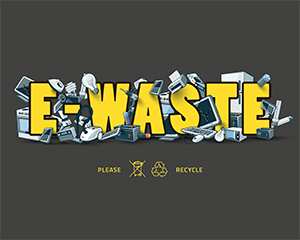
Featured Image: iStock.com/petovarga
Do you know where your cell-phones and laptops go to die? If they are not recycled or disposed-off, they pose real threat to the people living on this planet.
The global pile-up of e-waste is getting out of control. While there are various predictions from UN about the future size of waste, there are hardly any suggestions for counter-measures to minimize the load. On top of that, the new generation electronic devices like smartphones and laptops have an average lifespan of less than 2 years. This means a lot of e-waste will haunt us soon. Hence, it is important that every citizen in Philadelphia should know a few facts about the problem. Ladies and gentlemen, let’s embrace the horror!
Electronic waste disposal and management has grown into a globalized business because around 80% of this waste is shipped to the third world countries where it is further processed before being dumped into landfills. There is a reason why the e-waste continues to have some value in the developing countries. It is sorted or burnt to extract and sell scrap metal.
There is no doubt in the fact that e-waste is full of toxic elements. Up to 60 elements from the periodic table can be found in e-waste items. Moreover, flame retardants and toxic complex chemicals further pose difficulties in effective disposal. For instance, cadmium is a hazardous chemical which can pose real threats when exposed to humans or the environment. Hence the e-waste disposal is a big challenge. Other harmful components in e-waste include:
As we all know, the metals in e-waste devices are highly valuable, but the biggest impediment is the lack of safety protocol to extract them properly. The metals from cell phones, batteries can be recycled to manufacture new phones and other electronics items. In fact, some companies in Philadelphia extract metals like platinum, gold and selenium from used devices so that it can be used in the processing of refurbished devices.
Before you throw away your e-junk, make sure it does not end up with a fake recycler. The recycling of this waste can be a lucrative business if the junk is exported to the developing countries where scrap metal is reused. If it is sent off to be disassembled, then there are no safety precautions or enough money for the people who actually work on this waste.
It’s ironic how information on e-waste disposal is hard to come by. Several attempts by federal governments to develop laws for electronic waste management have never come to fruition. Philadelphia is also part of the Coalition for American Electronics Recycling (CAER) that operates in 218 facilities in almost 34 states. This organization is trying to get the bill passed for e-waste disposal, but so far only 25 states have passed and enacted laws regarding e-waste recycling.
All the big guns of the tech industry are now becoming a part of trade-in programs. Apple announced one such program that provides value against iPhone 4. If a client intends to buy a newer iPhone, the company will transfer the credit towards a newer product. The companies that took part and initiated the trade-ins include Dell, Apple and Google.
Did you know that China is the second country that generates most amount of e-waste after US? That might not be a surprise for some, but did you know that it is also the place where most of the electronic waste from the US is dumped. Guiyu is a town in Guangdong Province which is manufacturing zone that has also served as an electronic waste dumping hub for years. Now the region is extremely polluted because of the burning of circuit board and the use of hazardous chemical to recover important metal. This poses danger for the visitors and residents living in the surrounding areas.
In the absence of federal laws, the state laws are not counted as a top priority. In this backdrop, it is really hard for the recyclers in Philadelphia to understand how the world deals with e-waste. As the lifespan of our devices get shorter and the average number of electronics grows, it is getting harder for the government in Philadelphia to estimate how much waste is actually out there. There are some companies that claim to have recycled some of the e-waste products, but in reality, they are actually sold to other developing countries that rarely follow safety codes for extraction and recycling. Furthermore, EPA has confirmed that there is no reliable data available on the export of e-waste.
Do you know what becomes of the e-waste discarded by you? Is it piled up locally or burnt without a safety protocol? Stay informed, and share this e-waste fact file to spread the word.
Kelly Sampson is a writer, blogger, and environmental enthusiast. She has strong opinions about climate change, the dogs vs. cats debate, and Oxford commas. She has lent Hummingbird International her engaging and spirited voice and turned our blog into a great place to find valuable information about e-waste, e-waste recycling, and the ITAD industry. Explore our blog to read more of her work.